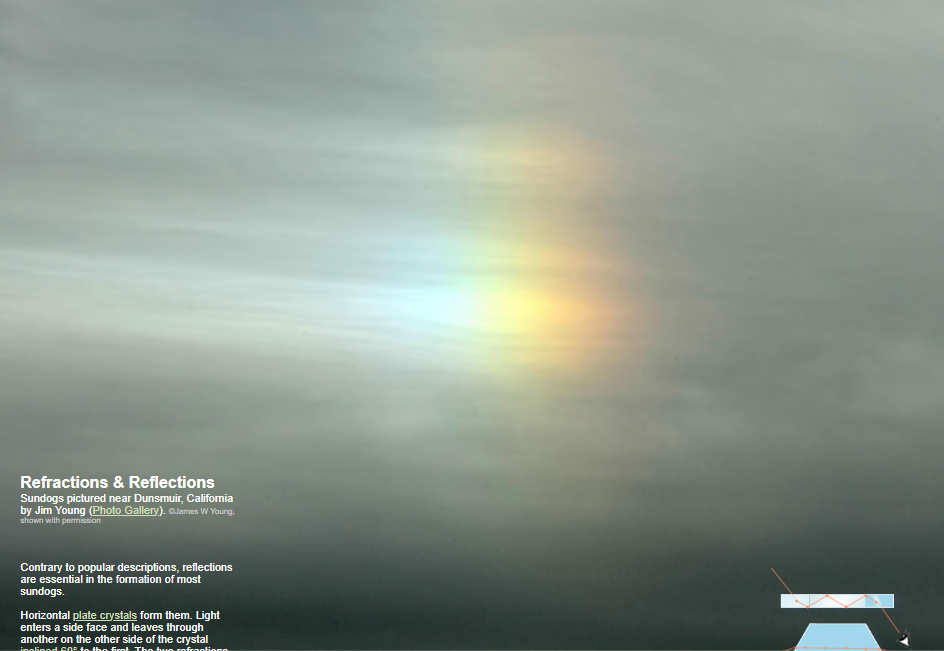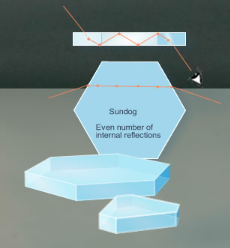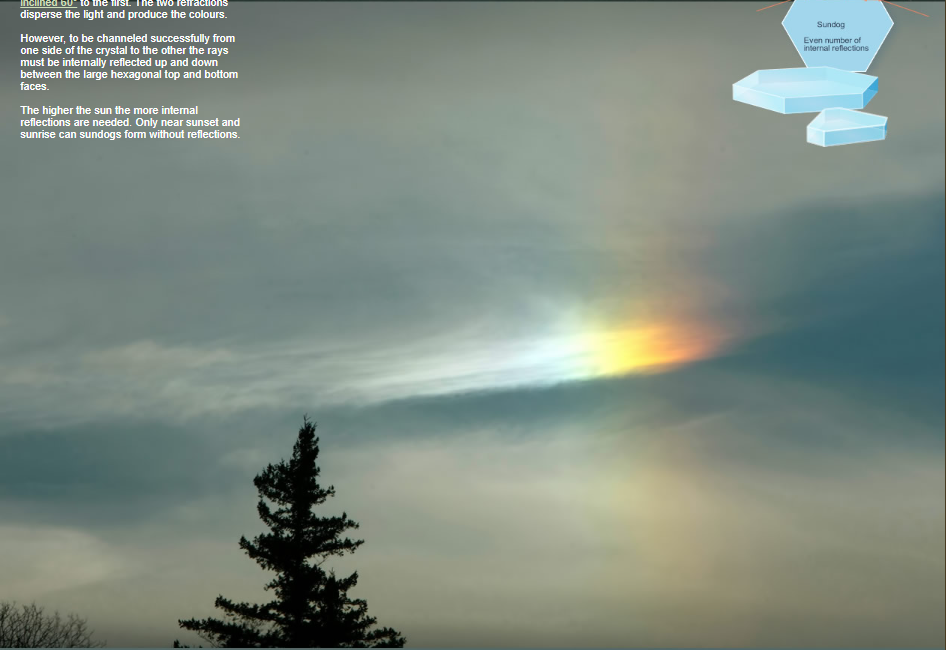OPOD - Reflections on Sundogs
OPOD - Reflections on Sundogs: A Closer Look at the Formation
Sundogs, also known as parhelia, are a captivating atmospheric phenomenon that often leaves observers in awe. Contrary to popular belief, reflections play a crucial role in the formation of most sundogs. These stunning displays of light are created by horizontal plate crystals, where light enters through one side face and exits through another, inclined at an angle of 60° to the first. This refraction of light causes dispersion and gives rise to the vibrant colors associated with sundogs.
However, for the light to successfully travel from one side of the crystal to the other, internal reflections are necessary. These internal reflections occur between the large hexagonal top and bottom faces of the crystal, effectively channeling the rays up and down. The number of internal reflections required depends on the position of the sun in the sky. As the sun rises higher, more internal reflections are needed for sundogs to form.
Interestingly, sundogs can only form without reflections during specific times of the day—near sunset and sunrise. During these moments, when the sun is low on the horizon, the angle of incidence allows for direct passage of light through the crystals, bypassing the need for internal reflections. It is these unique conditions that give rise to sundogs without reflections.
To fully appreciate the complexity of sundog formation, it is important to understand the science behind their occurrence. Here are some key points to consider:
-
Plate Crystals: Sundogs primarily form from horizontal plate crystals. These crystals have a flat, hexagonal shape and are responsible for bending and dispersing sunlight.
-
Refraction: When light passes through a side face of the crystal, it bends or refracts. This refraction occurs because the speed of light changes as it moves from one medium (air) to another (ice crystal).
-
Dispersed Light: The refraction of light through the crystal causes the different colors of the spectrum to separate or disperse, resulting in the vibrant hues seen in sundogs.
-
Internal Reflections: To travel from one side of the crystal to the other, the rays of light undergo internal reflections. These reflections occur between the top and bottom faces of the crystal, effectively bouncing the light up and down within the crystal.
-
Sun Position: The higher the sun is in the sky, the more internal reflections are required for sundogs to form. This is because the angle of incidence changes as the sun's position changes, affecting how light enters and exits the crystal.
-
Sundogs without Reflections: Near sunset and sunrise, when the sun is low on the horizon, sundogs can form without the need for internal reflections. The angle of incidence allows light to pass directly through the crystals, creating a stunning display of colors.
The intricate interplay between refractions, reflections, and sunlight gives rise to the captivating phenomenon of sundogs. Observing these atmospheric wonders can be a truly mesmerizing experience, as they showcase the beauty and complexity of nature's optical phenomena.
While this article has provided an overview of sundogs and their formation, there is much more to explore and discover about these intriguing atmospheric optics. So next time you catch a glimpse of a sundog painting the sky with vibrant colors, take a moment to appreciate the science behind its formation and marvel at the wonders of our atmosphere.

Refractions & Reflections
Sundogs pictured near Dunsmuir, California by Jim Young (Photo Gallery). ©James W Young, shown with permission

Contrary to popular descriptions, reflections are essential in the formation of most sundogs.
Horizontal plate crystals form them. Light enters a side face and leaves through another on the other side of the crystal inclined 60° to the first. The two refractions disperse the light and produce the colours.
However, to be channeled successfully from one side of the crystal to the other the rays must be internally reflected up and down between the large hexagonal top and bottom faces.
The higher the sun the more internal reflections are needed. Only near sunset and sunrise can sundogs form without reflections.

Note: this article has been automatically converted from the old site and may not appear as intended. You can find the original article here.
Reference Atmospheric Optics
If you use any of the definitions, information, or data presented on Atmospheric Optics, please copy the link or reference below to properly credit us as the reference source. Thank you!
-
<a href="https://atoptics.co.uk/blog/opod-reflections-on-sundogs/">OPOD - Reflections on Sundogs</a>
-
"OPOD - Reflections on Sundogs". Atmospheric Optics. Accessed on November 26, 2024. https://atoptics.co.uk/blog/opod-reflections-on-sundogs/.
-
"OPOD - Reflections on Sundogs". Atmospheric Optics, https://atoptics.co.uk/blog/opod-reflections-on-sundogs/. Accessed 26 November, 2024
-
OPOD - Reflections on Sundogs. Atmospheric Optics. Retrieved from https://atoptics.co.uk/blog/opod-reflections-on-sundogs/.